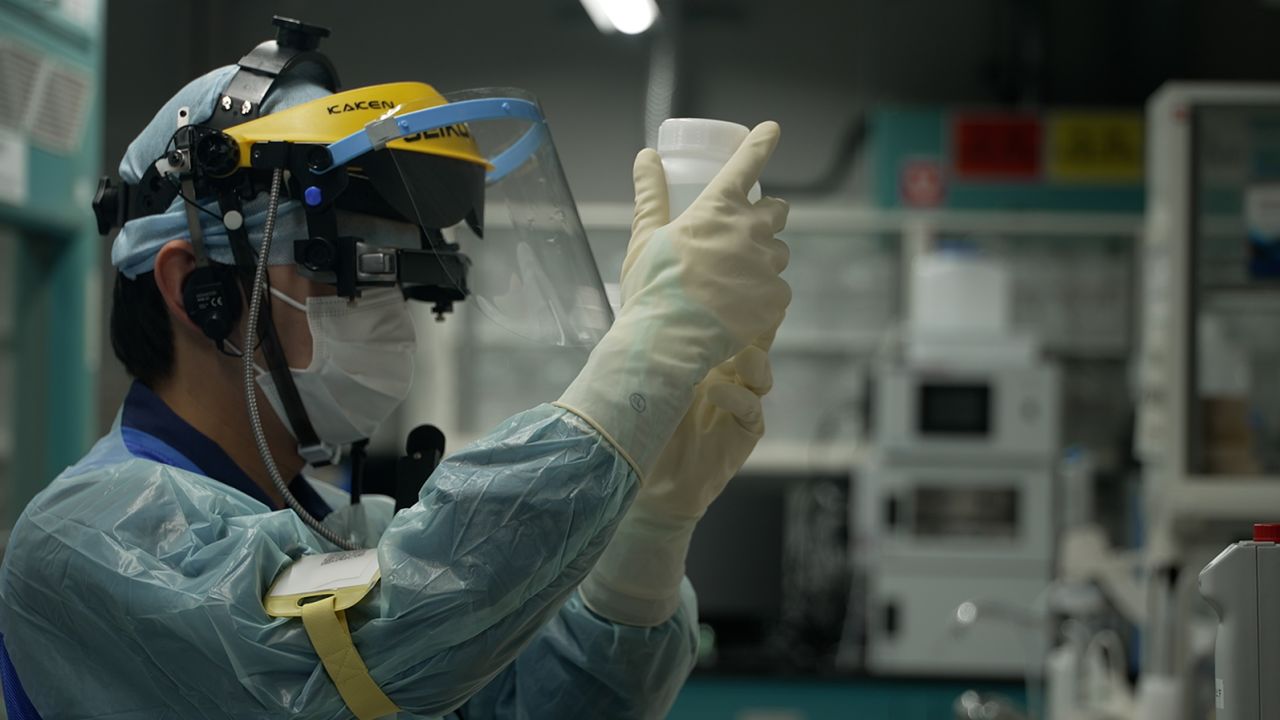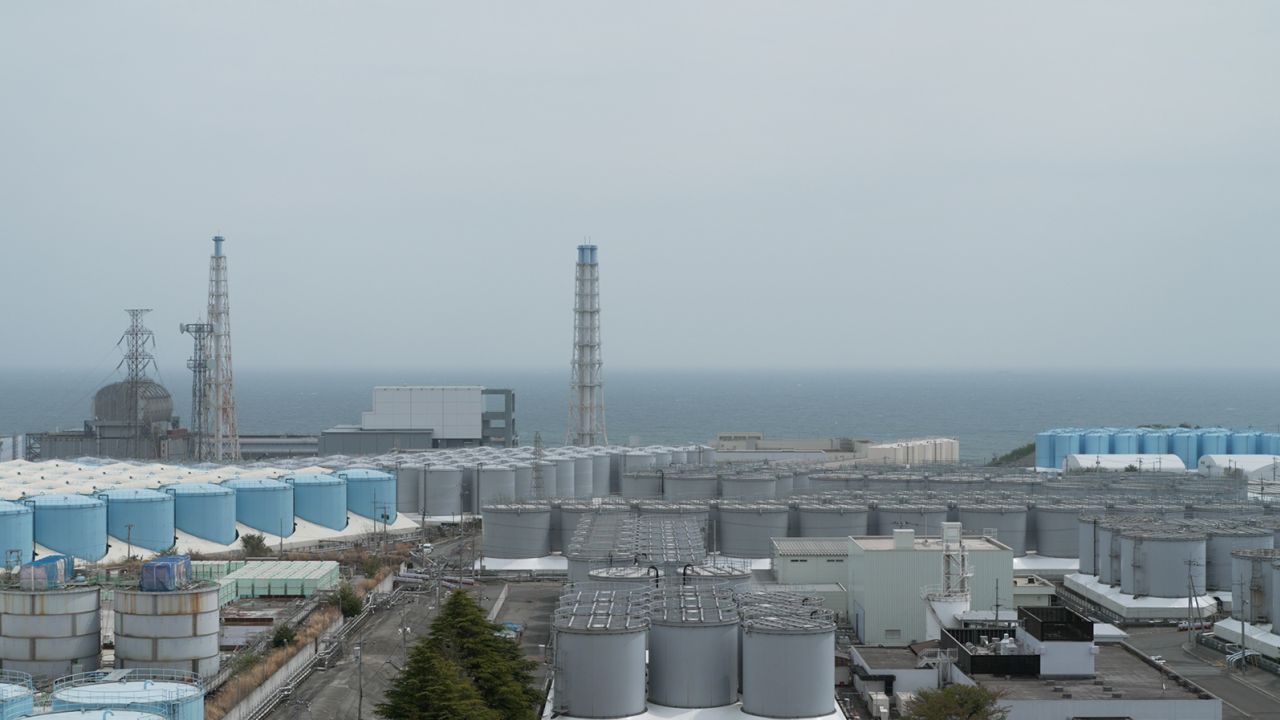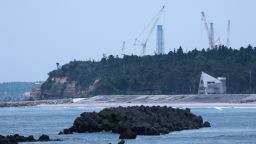日本排放核污染水(外刊阅读)
TokyoCNN — After months of controversy and anticipation, Japan is set to begin releasing treated radioactive wastewater from its Fukushima nuclear plant later this week despite fierce objections from some countries.
日本CNN:在数月的 争议和期待 之后,尽管受到某些国家的阻拦,日本计划在这周稍晚时间从福岛核电站释放经过处理后的核污染水。
The plan has been in the works for years, with authorities warning in 2019 that space was running out to store the material and they had “no other options” but to release it.
当局(官员)在 2019 年警告称存储核污染水的空间已经耗尽,他们“没有其他的选择”,只能排放核污染水之后,这个(排放的)计划已经持续数年了。
While some governments have expressed support for Japan, others have strongly opposed the wastewater release, with many consumers in Asia hoarding salt and seafood amid fears of future contamination.
在一些政府表达对日本的支持时,然而,其他政府强烈反对核污染水的排放。许多亚洲消费者已经 囤积 盐与海产品,从而减少对未来(排放)的恐惧。
Here’s what we know so far.
这是我们迄今为止所知道的内容。
When and how will it be released? 核污染水什么时候、怎么排放?
Japanese Prime Minister Fumio Kishida said Tuesday the government had formally decided to start releasing the water as early as Thursday, August 24, “if they encounter no obstacles.”
日本首相岸田文雄星期二时说,“如果他们没有遇到任何阻碍的话”,政府已经正式决定开始在8月24日星期四排放核污染水。
Over the years, the wastewater has been continually treated to filter out all the removable harmful elements, then stored in tanks. Much of the water is treated a second time, according to the state-owned electricity firm Tokyo Electric Power Company (TEPCO).
日本电力公司称,经过数年,核污染水已经持续经过处理,过滤出所有可移除的有害物质,然后把这些有害物质存储起来。许多核污染水也经过了二次处理。
When the wastewater is finally released, it will be be heavily diluted with clean water so it only has very low concentrations of radioactive material. It will travel through an undersea tunnel about 1 kilometer (0.62 miles) off the coast, into the Pacific Ocean.
当核污染水最终排放后,它将会与干净的水稀释,所以排放后的水只会有非常少的放射性物质。它将会通过一千米的海底隧道离开海岸,进入太平洋。
Third parties will monitor the discharge during and after its release – including the United Nations’ nuclear watchdog, the International Atomic Energy Agency (IAEA). The IAEA has staff stationed in a newly-opened Fukushima office and will monitor the situation for years to come, it said.
第三方(包括联合国核污染监测站,IAEA等)将会在排放期间和排放后监控discharge。IAEA说,它们外派工作人员在新修建的福岛办公室工作,他们会在几年内监测排放的局势。

A TEPCO researcher assesses the radiation impact of treated wastewater in Fukushima, Japan, on April 12, 2023.
Daniel Campisi/CNN
Why are they doing this? 为什么要干这回事?
The devastating 2011 earthquake and tsunami damaged the Fukushima nuclear plant’s power supply and cooling systems – causing the reactor cores to overheat and contaminate water within the plant with highly radioactive material.
毁灭性 的2011东日本大地震损坏了福岛核电站的电源供应和冷却系统,导致了反应炉核心过热,高放射性物质污染了水源。
Since then, new water has been pumped in to cool fuel debris in the reactors. At the same time, ground and rainwater have leaked in, creating more radioactive wastewater that now needs to be stored and treated.
自此之后,新的水被注入到反应炉以降低温度,同时地下水和与水进入也使得了更多的核污染水需要被存储和处理。
TEPCO built massive tanks to contain the wastewater, but space is quickly dwindling. The company says building more tanks isn’t an option, and it needs to free up space to safely decommission the plant.
TEPCO 修建了巨大的水仓来存储这些水,但是空间被急剧缩小。公司说,修更多的仓库已经不现实了,需要清理一些空间来安全的退役工厂。
IAEA Director General Rafael Grossi told CNN in July that Japan had considered five options for getting rid of the water, including vapor release, which would have seen wastewater boiled and released into the atmosphere.
IAEA 经理 Rafael Grossi 七月份告诉CNN说,日本已经考虑了五个选项来摆脱核废水,包括让核废水沸腾并蒸发到自然环境中的“释放蒸汽”方案。
But most of these options are “considered industrially immature,” he said. For instance, vapor release can be more difficult to control due to environmental factors like wind and rain, which could bring the waste back to Earth, he said. That left a controlled release of water into the sea – which is frequently done at nuclear plants around the world, including those in the United States.
但是大多数的这些选项都“在工业上并不成熟”。例如由于风和雨的环境因素,蒸汽释放方案可能更难实现,甚至可能让核污染水再度返还到地球上。这样就剩下了一个可控的方案——全球各地的核电站(包括美国)都经常做的那个方案)——把核污染水排放到大海里。

TEPCO has built over 1,000 massive tanks to store treated radioactive wastewater in Fukushima, Japan, on April 12, 2023.
Daniel Campisi/CNN
What are the risks? 有什么风险?
Though the radioactive wastewater contains some dangerous elements, the majority of these can be removed through various treatment processes, according to TEPCO.
TEPCO 说,即使核污染水包含了这么多危险放射性物质,但是主要物质已经通过多种方式去除了。
The real issue is there is no technology available to take away a hydrogen isotope called radioactive tritium, and authorities and experts are divided on the risk it poses, if any.
事实上的问题是没有可用的科技可以带走一种叫做放射性氚的氢同位素,并且当局和专家在其显露出的风险上产生分歧,如果有的话。
TEPCO, Japan’s government, and the IAEA argue that tritium occurs naturally in the environment, including in rain and tap water, so the wastewater is safe, especially as it will be released slowly over decades.
TEPCO,日本政府和IAEA认为氚来自于自然环境(包括雨和自来水),所以核污染水是安全的,特别是它将在几十年内被慢慢的释放出来。
But some scientists worry that the wastewater, even diluted, could harm marine life, and pollutants could accumulate in the already frail ecosystem.
但一些科学家担心,废水即使被稀释,也可能危害海洋生物,污染物可能在本已脆弱的生态系统中积聚。
One expert who helped Pacific Island nations review and assess the wastewater release plan told CNN it was “ill-advised” and premature.
一个帮助过太平洋岛屿核污染水排放的专家告诉 CNN,(日本)计划太“不明智”并且为时过早。
Others argue we just don’t have enough studies or data yet on the longer-term biological effects of exposure to tritium.
其他人认为我们还没有足够的研究和数据来表明氚长期的生物效果。
What have other governments said? 其他政府怎么说?
The plan has met a mixed reaction, with support from some corners and skepticism from others.
日本排放核废水的计划,国际社会上褒贬不一:某些邻居支持排放,而某些邻居强烈阻止。
The US has backed Japan, and nearby Taiwan has agreed that the amount of tritium being released should have “minimal” impact.
美国支持日本,并且日方周边的“台湾当局”也同意日本排放可以带来“最小”的后果。
But China and the Pacific Islands have been vocal in their opposition, arguing the release could have broad regional and international impact, and potentially threaten human health and the marine environment. Some governments have even banned food imports from parts of Japan, including Fukushima.
但是中国和太平洋岛国也在发生认为这次排放可能带来区域性的和国际性的影响,并且影响到人类健康和海洋环境。有些政府甚至禁止了从日本某些地方(包括福岛)的食物进口。

Hong Kong poised to ban Japanese seafood over treated nuclear wastewater
While South Korean leaders have largely supported the plan, opposition politicians have voiced their alarm and protesters have called for it to be stopped.
韩国领导人强烈支持这个计划,但是反对派敲响警钟,呼吁应该停止计划。
Public anxiety has grown, too, with seafood lovers in mainland China, Hong Kong, and elsewhere vowing to stop eating Japanese products once the wastewater is released. Some shoppers have stocked up on sea salt and items like seaweed or anchovies, for fear these products may be impacted.
民众意见也在不断发酵。 中国大陆香港和其他地区的海鲜爱好者说,一旦核污染水释放之后,将不会再吃日本的海产品。有些消费者已经因为恐惧核污染水排放后的影响而囤下了海盐和其他海产品。
The blowback has worried fishing communities in Japan and South Korea, who say this could spell the end of their livelihoods – especially those in Fukushima, where the fishing industry is now worth just a fraction of what it once was before the 2011 disaster.
这种反弹让日本和韩国的钓鱼社区们担忧,他们认为这可能结束他们的生活,特别是那些福岛的渔民,那里的渔业工业只是东日本大地震之前的一小部分。